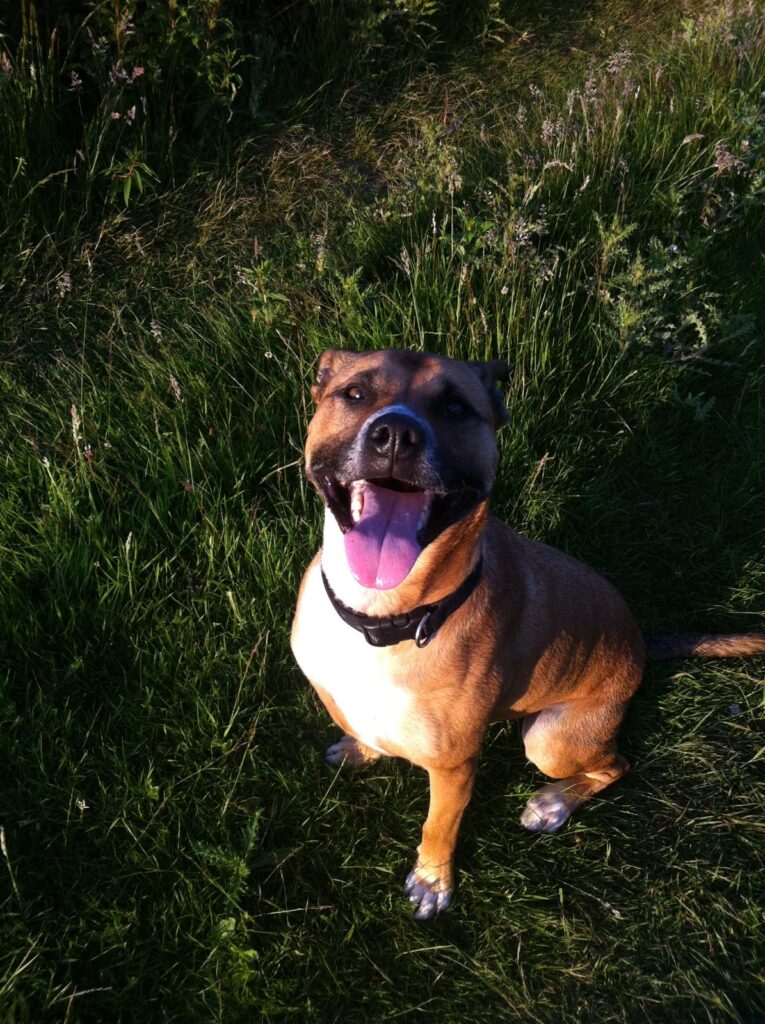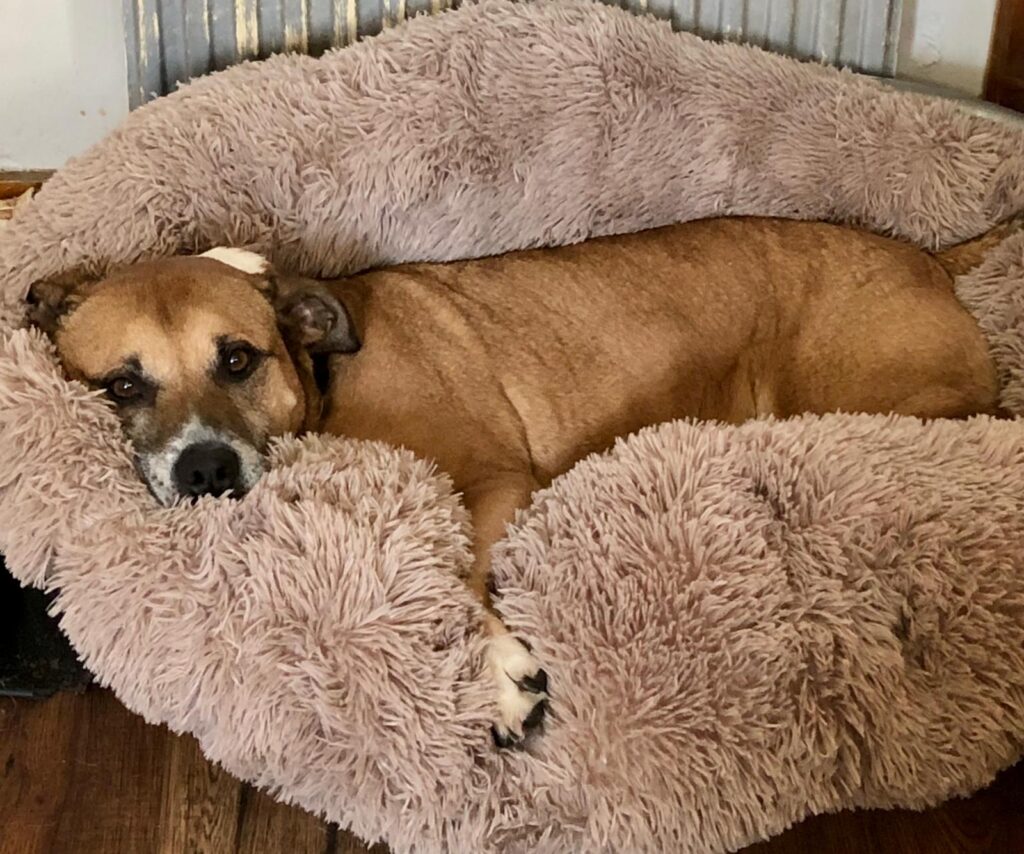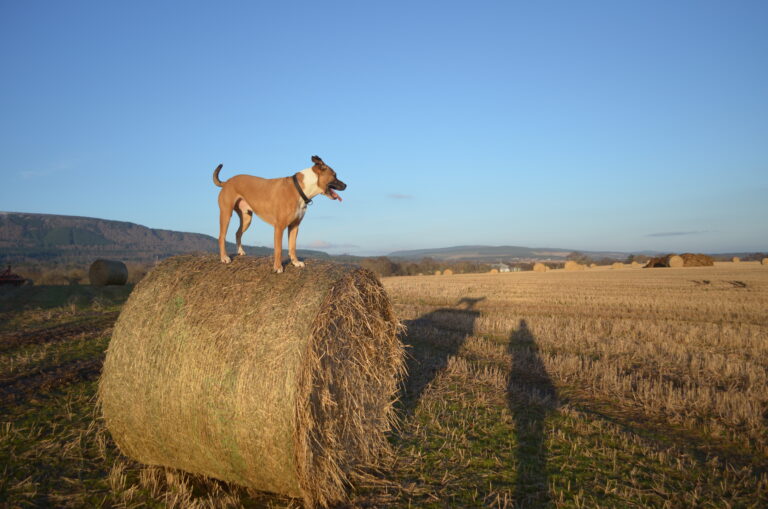Adopting a rescue dog is a big deal, but bringing a rescue dog home who is nervous or fearful is a whole different ball game. Fifteen years ago we brought home Dizzy, an adult dog who was very upset and found it difficult to relax in his new environment.
It took extra time, love and a lot of patience to help him feel safe and settled. This is our story, how we helped him overcome his fearfulness, and how you can do the same with a little time.

Setting Expectations with Adult Dog Anxiety
Like humans, many dogs, especially rescues, come with emotional baggage. A dog learns from his past and how he has been treated. It is very important to set expectations early, as the journey of them feeling comfortable may take longer than expected.
How Can Anxiety Manifest?
Rescue dogs have been through trauma, neglect or abandonment and as a result can be anxious and fearful in their new environment. This anxiety can manifest in many ways, skittishness, fear of objects or people and general nervousness.
Dizzy was a nervous, underweight adult dog, who had not had a ‘puppy hood’. He had developed bad habits, didn’t really know to play and was ‘just about’ house trained. Helping him settle took extra time, patience and creating a safe and loving space. We had to set expectations early.
Dizzy’s First Night With Us
Dizzy’s first night with us over ten years ago was tough. He wouldn’t eat or drink or leave his bed no matter how many of a delicious treat we offered him. The sadness in his eyes was gut wrenching but we knew we had to give him extra time to settle. From experience, below are some tips on how to help your rescue dog feel comfortable.
Creating A Safe Space
Creating a safe space is one of the first things to help a nervous rescue dog feel calm in a new location. A quiet space, free from noise and activity and with their bed, toys and other comfort items is perfect. Crate training can also be very effective, as the crate can provide a private retreat for your dog when they feel overwhelmed.

Creating a Safe Space 101
Pick a Stress Free Room: Choose a room in your house away from the main living areas. This will help keep the noise and activity to a minimum.
Use a Crate: A crate can be a safe space for a fearful dog as it’s’ confined and comfortable. Add in a soft bed, blanket and some toys.
Add in Familiar Items: Familiar smells will help them feel more settled. If possible bring items from the dog’s previous home, a blanket or toy.
Establishing a Routine
Dogs thrive on routine and rescue dogs especially benefit from a daily schedule. A structured day reduces anxiety by providing predictability and security. Include regular feeding times, exercise, walks and rest periods to help your dog settle in.
Why Sticking To A Routine Makes All The Difference
Stick to a daily plan and your pet will know what to expect which can be very comforting. For Dizzy, having a routine made all the difference. The predictability of his daily activities helped reduce his constant anxiety and he could relax. Knowing when he would be eating, walked and played with helped him trust that his needs would be met regularly and reduce his stress and build his confidence.
Predictability
A daily routine also helps manage your dog’s energy and reinforce good behaviour. Knowing what’s going to happen and when will help your dog adjust and feel more secure in their new home. This will also help with housetraining if needed.
Have Patience
Patience is key when dealing with an anxious rescue dog. Move at the dog’s pace and don’t push them into uncomfortable situations. Dogs learn at different speeds so you may need to wait longer for them to come out of their crate or take shorter, slower walks until they feel more settled.

Positive Reinforcement and Treats
Positive reinforcement is a great way to encourage good behaviour and build trust. Use treats and plenty of praise to reward your dog when they demonstrate good behaviour.
How to Use Positive Reinforcement
High Value Treats: Find your dog favourite treat and feed them to reward good behaviour.
Praise and Petting: In addition to treats, use verbal praise and gentle petting to reinforce good behaviour.
Consistency is key: Always reward the behaviour you want to encourage.
Specific Anxieties
Below are some common anxieties your dog may have, and how to best deal with them.
Separation Anxiety
Separation anxiety is common in rescue dogs. Start by leaving your dog alone for short periods and gradually increase the time. Make sure they have plenty of toys and things to do while you’re away. Using baby gates to block off certain areas of the house can create a smaller more contained space which may help them feel more secure.

Fear of Walks
If your dog is fearful of walks, start with short quiet walks and slowly increase the distance and duration over time. Always carry treats and give them frequently to associate walking with positive experiences. Keep them on a lead at first while you get to know your pup.
Fear of Specific People or Objects
Some rescue dogs have specific fears, men with hats or people with canes, for example. These fears often stem from past experiences. Dizzy was terrified of my grandad’s walking stick. To help your dog overcome these fears use desensitization and counter conditioning. Gradually expose your dog to the feared person or object in a controlled way, use treats and praise to create positive associations.

Fear of Other Dogs
If your rescue dog is dog phobic introduce them slowly in controlled environments. Start with calm friendly dogs and have interactions at a distance. Gradually decrease the distance as your dog becomes more comfortable. Use treats and praise to reinforce good interactions and watch for signs of discomfort to not overwhelm them.
Housetraining an Adult Rescue Dog
Housetraining an adult rescue dog can be tough but it’s doable with consistency. Establish a toilet schedule and take your dog out frequently during set times of the day. As usual, remember to praise and reward them when they go in the right spot to reinforce good behaviour.
Take your dog out at the same times each day, morning, after meals, after naps and before bed. An elimination schedule will teach your dog when to go to the toilet.
Take your dog to the same spot each time for that familiar smell
Use a specific command like “potty” when you take your dog to the designated spot. This will help them associate the command with the action.
Praise and reward your dog immediately after they go in the right spot.
Keep an eye on your dog when they are indoors especially in the first few weeks. Watch for signs they need to go like sniffing or circling and take them outside straight away.
Use baby gates to block off areas of the house when you can’t supervise them. This prevents accidents and makes it easier to monitor their behaviour.
If your dog has an accident indoors clean it thoroughly with an enzymatic cleaner to remove the smell. This will stop them going back to the same spot.
Helping Your Dog Settle at Night
Getting a rescue dog to settle at night is often the hardest part of the adjustment period. Creating a night time routine that makes your pet feel safe and comfortable is key.

Night Time Routine
Bedtime Routine: Create a consistent bedtime routine to tell your dog it’s time to wind down. This could be a final walk, a calm play session or some quiet time together.
Comfortable Sleeping Arrangements: Make sure your dog has a comfortable and safe place to sleep. They may chew their bed at first. A crate with soft bedding can provide a sense of security. Some dogs prefer to sleep in their crate with the door open, others prefer the door closed.
Don’t Overstimulate: Before bed avoid activities that will overstimulate your dog. Instead do calm activities like gentle petting or quiet time.
Night Time Comfort Items: Give your pet comfort items like their favourite blanket or a piece of your clothing. The familiar scent will be soothing.
Nightlights: Some dogs feel more secure with a little light. Consider using a nightlight in the room if your dog is afraid of the dark.
Dizzy’s First Nights
Dizzy struggled to settle at night initially. He would pace and whine, clearly anxious about his new surroundings. We created a calming bedtime routine that included a final walk and a treat in his crate. Over time Dizzy learned to associate these activities with bedtime and would settle and sleep peacefully.
Still Have Questions? The FAQs
What do you do with an anxious or nervous adult dog?
Create a safe space, routine and positive reinforcement. Be patient and let your dog adjust at their own pace.
How long does it take for a rehomed dog to settle?
A few weeks to several months for a rehomed dog to settle into their new home depending on their past experiences and the new environment.
What is the 3-3-3 rule for dog anxiety?
The 3-3-3 rule explains the three stages of adjustment. The first three days are for settling, the first three weeks are for getting to know your dog and the first three months are for building trust and bonding.
What do I do if my dog is frightened of walks?
Start with short quiet walks and gradually increase the distance and duration. Use treats and positive reinforcement to help your dog associate walks with good things.
How do I build trust with a scared dog?
Building trust with a scared dog takes time and patience. Use positive reinforcement, don’t force your dog into uncomfortable situations and let them come to you on their terms. Create a safe space for them.
Is it normal for a newly adopted dog to have accidents in the house?
Yes it’s normal for a newly adopted dog to have accidents in the house as they settle into their new environment. Create a routine, take your dog out frequently and use positive reinforcement when they go in the right place.
How long does it take to house train an adult rescue dog?
House training an adult rescue dog can take several weeks to a few months depending on the dog’s history and the consistency of the training.
The End Part
Adopting a rescue dog and helping them overcome their fears is a journey of ups and downs. By creating a safe space, routine, positive reinforcement and being patient you can help your rescue dog feel safe and loved in their new home.
Every step of the way is a win and over time your bond with your dog will grow. Dizzy lived with us for 16 years and passed away peacefully. His story is proof that patience, love and consistency can turn a scared rescue dog into a family pet.









